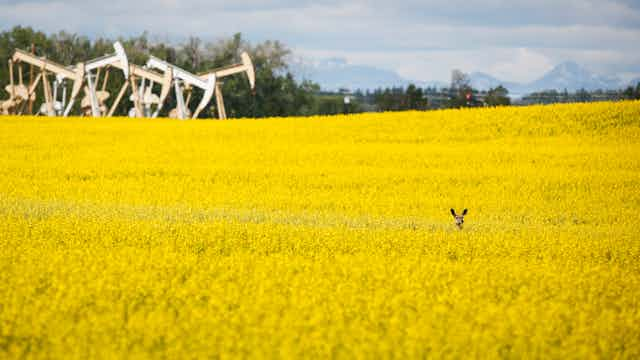Problems in Canada’s food system are being felt from field to fork — and they are increasingly hard to swallow.
After a year of skyrocketing food costs, Canada’s Food Price Report 2024 predicts a further increase of 2.5 to 4.5 per cent for grocery store price tags.
One cause for these higher prices — apart from corporate greed — is attributable to more difficult environmental conditions for farmers. Severe weather events, like flooding and drought, as well as extreme temperatures, are making farming livelihoods increasingly precarious.
Read more: How nature-based knowledge can restore local ecosystems and improve community well-being
This is the case in the Prairie provinces, where immense, export-oriented monoculture farming operations are the norm. These industrial farms are intimately connected to the climate crisis. Industrial farms are highly dependent on emissions-intensive — and expensive — inputs like fertilizers and pesticides and face challenges in adapting to changing climate conditions with agility.
Agroecology
The National Farmers Union of Canada has been calling for a shift away from industrial agriculture toward more ecologically-centred farming methods with 2015’s Nyéléni Declaration on agroecology serving as the primary guideline. Around the world, this approach to farming is often called agroecology.
Agroecology refers to the use of specific farm management practices that recycle nutrients and resources and benefit from interactions between multiple species of crops and animals in the same area. However, because agroecological farming tends to use fewer chemical inputs and does not operate as monocultures, it is often more labour-intensive.
Agroecology differs from other, perhaps more familiar, farming systems like organic or regenerative. It is grassroots in nature and extends beyond farming practices alone by urging practitioners to explore and challenge current food system power relations.
Agroecology emphasizes community-building and advocacy as much as ecological farming systems. Simply put, it is as much a tool for social transformation as it is a set of farming practices, and for transnational agrarian movement La Via Campesina, it is the pathway to food sovereignty.

Farmers and scholars tend to think of agroecology as synonymous with small-scale, diversified farming, invoking pastoral images of lush market gardens with free-roaming hens and mixed orchards on the horizon. With this essentialist view, one would not expect agroecological farms to emerge on the Canadian Prairies, a place where large-scale commodity production is ubiquitous.
In 2016, the average farm size in Saskatchewan was 1,784 acres and farms in this region are getting bigger. At the same time, there are fewer farmers with more mechanized and automated farms.
The financialization of agriculture and the growing cost of land also makes it difficult for first-generation farmers to start farming. These issues further lock-in dominant industrial agriculture practices in the region.
What’s more, the average farmer age currently stands at 56, with successors becoming rarer and rarer with each passing year. The end result of all of these factors is a trend towards farm concentration that leaves little room for those who want to farm the Prairies using ecological practices. Under these conditions, one may not expect to find the seeds of agroecology on the Prairies.
However, farmers in our study offer glimpses into their visions for agroecology as they attempt to translate its principles onto the prairie landscape, despite overlapping challenges.
Prairie agroecology
Amidst the fields of industrial farms, some farmers are opting to prioritize the ecological well-being of their land through farming practices that conserve water and enhance soil health. In our recent study we interviewed farmers from 19 farms across the Prairies — during the 2021 season — and found that with enough commitment and support from their surrounding community, agroecology can be a viable path forward.
There are struggles, though. Burnout is a serious issue for farmers practicing agroecology. The vastness of the Prairies and the ubiquitous presence of industrial farming can make it difficult for ecological farmers to connect with like-minded folks. Organizations like the Harvest Moon Society in Manitoba offer important exceptions and build supportive networks for ecological farmers on the Prairies.
Bringing more people to the land
Scaling agroecology out across the Prairies would require policies that lower the barriers to entry for new farmers. Additionally, policies must be developed that support and encourage farmers who use ecological farming practices — especially young farmers.
Moreover, fostering a community among ecological farmers is crucial to counter the isolation — and risk of burnout — felt by many farmers embarking on a mission to produce food on the Prairies through ecological methods. More fundamentally, since this approach to farmer is labour-intensive, ecological farming will require more people to help out.
There is a tension between the need to bring more people to the land and the historical role of Canadian agriculture in “clearing the plains” as an act of settler colonialism. Bringing more people to the land should also respond to this historical context.
A just ecological transition must honour “land back” calls prioritizing re-matriating crown lands to Indigenous communities and building accountable relationships between farm-owners and Indigenous communities.
Prairie agroecology can help a just transition
Canada’s farming system needs a transition to both mitigate and adapt to the climate crisis. However, a transition to ecological farming on the Prairies is not just a matter of agricultural practice, but also of social justice.
Ensuring equitable land access and respecting Indigenous rights and sovereignty are just a few of the key areas of concern that farmers and policymakers alike must reckon with.
Read more: How culturally appropriate diets can be a pathway to food security in the Canadian Arctic
Advancing agroecology on the Prairies would mean navigating challenges with land politics, labour and the legacy of colonialism. These are huge challenges and we feel agroecology can help address them while also building better relationships between people and the land.

